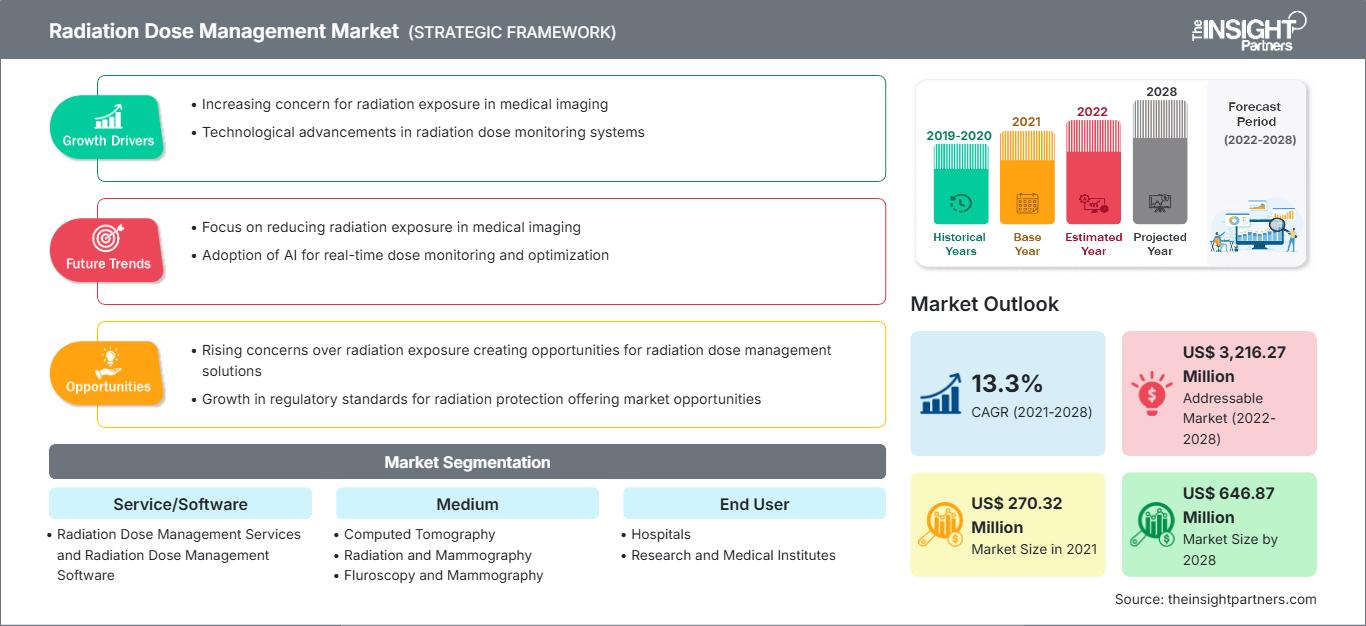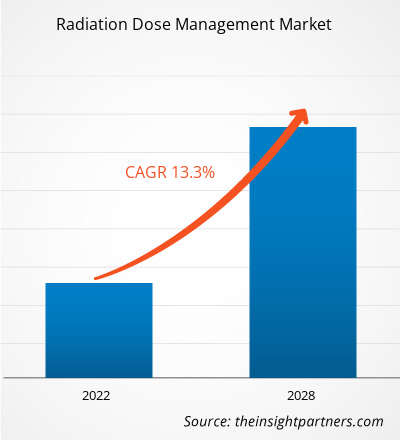Le marché de la gestion des doses de rayonnement devrait atteindre 646,87 millions de dollars américains d'ici 2028, contre 270,32 millions de dollars américains en 2021 ; sa croissance est estimée à un TCAC de 13,3 % entre 2021 et 2028.
La radiothérapie est une branche essentielle de la science médicale. Diverses maladies comme le cancer, les maladies cardiovasculaires, etc., sont diagnostiquées et traitées par ondes électromagnétiques. Elle est largement utilisée pour traiter différents types de cancer. Cependant, la radiothérapie a également des effets secondaires. Par conséquent, la surveillance de la dose de rayonnement correcte est essentielle dans toute procédure médicale impliquant des radiations. La dose de rayonnement est la quantité de rayonnement projetée sur le patient. La gestion des doses de rayonnement comprend les informations sur les logiciels d'enregistrement des doses de rayonnement ; la surveillance en temps réel des doses du personnel ; la conformité réglementaire ; et les technologies de réduction des doses, telles que les logiciels de reconstruction interactive.
La croissance du marché de la gestion des doses de rayonnement est attribuée aux préoccupations croissantes liées à l'exposition aux radiations et à l'augmentation des cas de cancer nécessitant une radiothérapie. Cependant, les défis organisationnels et le manque d’analyse comparative pour l’optimisation des doses entravent la croissance du marché.
Vous bénéficierez d’une personnalisation sur n’importe quel rapport - gratuitement - y compris des parties de ce rapport, ou une analyse au niveau du pays, un pack de données Excel, ainsi que de profiter d’offres exceptionnelles et de réductions pour les start-ups et les universités
Marché de la gestion des doses de rayonnement: Perspectives stratégiques

-
Obtenez les principales tendances clés du marché de ce rapport.Cet échantillon GRATUIT comprendra une analyse de données, allant des tendances du marché aux estimations et prévisions.
Aperçu du marché
Prise de conscience croissante de la radiologie interventionnelle et de la médecine nucléaire
Les progrès rapides des technologies médicales, de la fabrication de dispositifs et des équipements d'imagerie ont permis d'affiner des procédures originales grâce à de meilleures techniques et d'élargir les indications des procédures. De nouvelles techniques ont été développées et certaines sont migrées vers d'autres modalités d'imagerie. Grâce à la grande efficacité de l'imagerie, de plus en plus de procédures de radiologie interventionnelle et de médecine nucléaire sont réalisées dans le monde entier. Selon la Society of Nuclear Medicine, environ 20 millions de procédures de médecine nucléaire sont réalisées aux États-Unis chaque année. Selon la World Nuclear Association, plus de 10 000 hôpitaux dans le monde utilisent des radio-isotopes en médecine et 90 % des procédures utilisant des radio-isotopes sont diagnostiques. Des acteurs du marché tels que Bayer Healthcare et Sectra Medical Systems proposent des logiciels de gestion de dose spécifiquement conçus pour la gestion des données de référence en imagerie interventionnelle et en médecine nucléaire. Par conséquent, l'intérêt croissant pour la radiologie interventionnelle et la médecine nucléaire offre des opportunités de croissance pour le marché.
Informations sur les services et les logiciels
Sur la base des services et des logiciels, le marché mondial de la gestion des doses de rayonnement a été segmenté en services de gestion des doses de rayonnement et en logiciels de gestion des doses de rayonnement. Le segment des logiciels de gestion des doses de rayonnement détenait la plus grande part de marché en 2021 et devrait enregistrer un TCAC de 13,6 % sur le marché au cours de la période de prévision.
Informations sur les supports
Sur la base des supports, le marché mondial de la gestion des doses de rayonnement est segmenté en tomodensitométrie, radiothérapie et mammographie, fluoroscopie et mammographie, et autres supports. Le segment de la tomodensitométrie détenait la plus grande part de marché en 2021 et devrait enregistrer un TCAC de 13,8 % sur le marché au cours de la période de prévision.
Aperçu régional du marché de la gestion des doses de rayonnement
Les tendances et facteurs régionaux influençant le marché de la gestion des doses de rayonnement tout au long de la période de prévision ont été détaillés par les analystes de The Insight Partners. Cette section aborde également les segments et la géographie du marché de la gestion des doses de rayonnement en Amérique du Nord, en Europe, en Asie-Pacifique, au Moyen-Orient et en Afrique, ainsi qu'en Amérique du Sud et en Amérique centrale.
Portée du rapport sur le marché de la gestion des doses de rayonnement
| Attribut de rapport | Détails |
|---|---|
| Taille du marché en 2021 | US$ 270.32 Million |
| Taille du marché par 2028 | US$ 646.87 Million |
| TCAC mondial (2021 - 2028) | 13.3% |
| Données historiques | 2019-2020 |
| Période de prévision | 2022-2028 |
| Segments couverts |
By Service/Logiciel
|
| Régions et pays couverts |
Amérique du Nord
|
| Leaders du marché et profils d'entreprises clés |
|
Densité des acteurs du marché de la gestion des doses de rayonnement : comprendre son impact sur la dynamique des entreprises
Le marché de la gestion des doses de rayonnement connaît une croissance rapide, portée par une demande croissante des utilisateurs finaux, due à des facteurs tels que l'évolution des préférences des consommateurs, les avancées technologiques et une meilleure connaissance des avantages du produit. Face à cette demande croissante, les entreprises élargissent leur offre, innovent pour répondre aux besoins des consommateurs et capitalisent sur les nouvelles tendances, ce qui alimente la croissance du marché.

- Obtenez le Marché de la gestion des doses de rayonnement Aperçu des principaux acteurs clés
- Analyse historique (2 ans), année de base, prévision (7 ans) avec TCAC
- Analyse PEST et SWOT
- Taille du marché Valeur / Volume - Mondial, Régional, Pays
- Industrie et paysage concurrentiel
- Ensemble de données Excel
Rapports récents
Rapports connexes
Témoignages
Raison d'acheter
- Prise de décision éclairée
- Compréhension de la dynamique du marché
- Analyse concurrentielle
- Connaissances clients
- Prévisions de marché
- Atténuation des risques
- Planification stratégique
- Justification des investissements
- Identification des marchés émergents
- Amélioration des stratégies marketing
- Amélioration de l'efficacité opérationnelle
- Alignement sur les tendances réglementaires






















 Obtenez un échantillon gratuit pour - Marché de la gestion des doses de rayonnement
Obtenez un échantillon gratuit pour - Marché de la gestion des doses de rayonnement